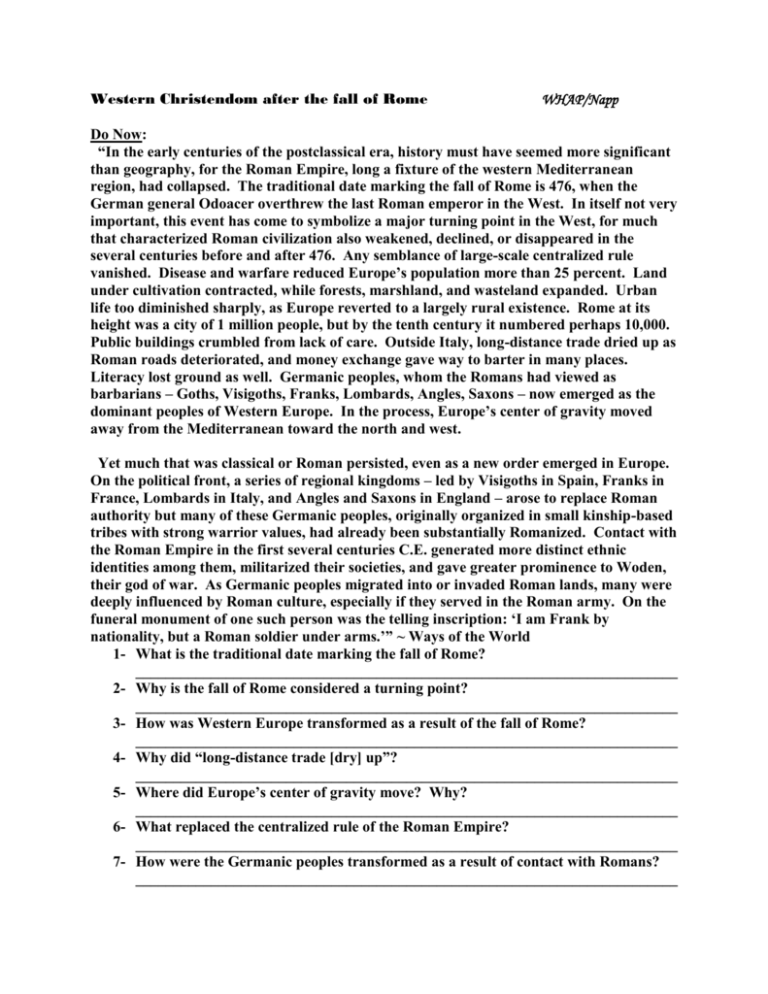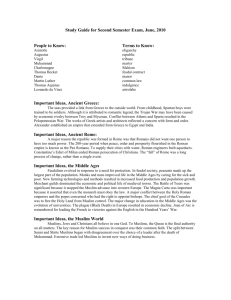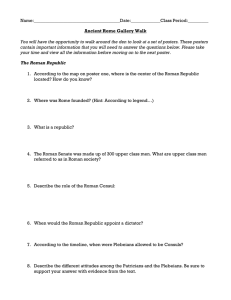Western Christendom after the fall of Rome WHAP/Napp Do Now
advertisement

Western Christendom after the fall of Rome WHAP/Napp Do Now: “In the early centuries of the postclassical era, history must have seemed more significant than geography, for the Roman Empire, long a fixture of the western Mediterranean region, had collapsed. The traditional date marking the fall of Rome is 476, when the German general Odoacer overthrew the last Roman emperor in the West. In itself not very important, this event has come to symbolize a major turning point in the West, for much that characterized Roman civilization also weakened, declined, or disappeared in the several centuries before and after 476. Any semblance of large-scale centralized rule vanished. Disease and warfare reduced Europe’s population more than 25 percent. Land under cultivation contracted, while forests, marshland, and wasteland expanded. Urban life too diminished sharply, as Europe reverted to a largely rural existence. Rome at its height was a city of 1 million people, but by the tenth century it numbered perhaps 10,000. Public buildings crumbled from lack of care. Outside Italy, long-distance trade dried up as Roman roads deteriorated, and money exchange gave way to barter in many places. Literacy lost ground as well. Germanic peoples, whom the Romans had viewed as barbarians – Goths, Visigoths, Franks, Lombards, Angles, Saxons – now emerged as the dominant peoples of Western Europe. In the process, Europe’s center of gravity moved away from the Mediterranean toward the north and west. Yet much that was classical or Roman persisted, even as a new order emerged in Europe. On the political front, a series of regional kingdoms – led by Visigoths in Spain, Franks in France, Lombards in Italy, and Angles and Saxons in England – arose to replace Roman authority but many of these Germanic peoples, originally organized in small kinship-based tribes with strong warrior values, had already been substantially Romanized. Contact with the Roman Empire in the first several centuries C.E. generated more distinct ethnic identities among them, militarized their societies, and gave greater prominence to Woden, their god of war. As Germanic peoples migrated into or invaded Roman lands, many were deeply influenced by Roman culture, especially if they served in the Roman army. On the funeral monument of one such person was the telling inscription: ‘I am Frank by nationality, but a Roman soldier under arms.’” ~ Ways of the World 1- What is the traditional date marking the fall of Rome? ________________________________________________________________________ 2- Why is the fall of Rome considered a turning point? ________________________________________________________________________ 3- How was Western Europe transformed as a result of the fall of Rome? ________________________________________________________________________ 4- Why did “long-distance trade [dry] up”? ________________________________________________________________________ 5- Where did Europe’s center of gravity move? Why? ________________________________________________________________________ 6- What replaced the centralized rule of the Roman Empire? ________________________________________________________________________ 7- How were the Germanic peoples transformed as a result of contact with Romans? ________________________________________________________________________ I. Fiefs and Faith: Western Europe after the fall of Rome A. A highly fragmented and decentralized society with great local variation B. Independent, self-sufficient, and largely isolated landed estates or manors 1. A manor was the lord’s land; an agricultural estate C. Lesser lords and knights swore allegiance to lords thus becoming vassals 1. Vassals received land in return for military service to lords (Feudalism) D. Roman slavery gave way to serfdom 1. Serfs were not personal property and could not be arbitrarily thrown off the land rather they were bound to the lord’s land E. Absence of central Roman authority, only security lay manors II. Roman Catholic Church 1. Hierarchical organization (pope, bishops) modeled on Roman Empire 2. Began the process of converting many of Europe’s “pagan” peoples 3. Provided unity and stability during a time of political fragmentation 4. By 1100, most of Europe had embraced Christianity 5. Church was a center of literacy, received tithes (taxes), wealthy landowner III. Church Controversies 1. Investiture Controversy during the eleventh and twelfth centuries 2. Church officials and kings debated who had the right to make Church appointments but eventually Church officials were given the right IV. Pace of change in West picked up in several centuries after 1000 A. By 1000, invasions had been checked and invaders absorbed into societies 1. Commonly called the High Middle Ages (expansion and commerce occurred) V. Stability and Trade A. Urbanization was proceeding as towns and cities once again attracted people 1. Groups organized themselves into guilds or associations of people pursuing the same line of work in order to regulate professions B. For women, religious life provided opportunities [nuns as in Buddhist lands too] C. A further sign of change: 11th – 13th century, monarchs became more powerful VI. The Crusades A. Beginning in 1095, the Crusades or a series of “holy wars” B. Crusaders were offered an indulgence, which removed penalties for sins C. But by 1291, Muslim forces had recaptured all of the temporary Christian states established in the eastern Mediterranean 1. “Successful failures”: Europeans lost permanent control of the land but gained ideas from Islamic golden age 2. Europeans rediscovered their own classical ideas in Muslim libraries 3. Stimulated European scholars to seek out original Greek texts 4. But also tremendous cruelty: slaughtered Muslims and Jews 5. Crusading elsewhere too: Spanish waged war for centuries to reclaim the Iberian Peninsula from Muslim hands (Reconquista) 6. Europeans also learned techniques for producing sugar on large plantations using slave labor from Muslims 7. Muslim scholarship, together with Greek learning it incorporated, also flowed into Europe, largely through Spain and Sicily 8. European empire building (Americas) continued crusading spirit 1- Describe Western Europe after the fall of Rome. ________________________________________________________________________ 2- What was a medieval manor [the Middle Ages or Medieval Period dates from the fall of Rome to the Renaissance – although some scholars consider the Renaissance part of this period]? ________________________________________________________________________ 3- Define a vassal. ________________________________________________________________________ 4- Define a serf. ________________________________________________________________________ 5- Define feudalism. ________________________________________________________________________ 6- Therefore, feudalism is a political and military system based on loyalty and exchanges. Look at the diagrams of the feudal hierarchy and the manor below. Identify three characteristics of each. 7- What did the Roman Catholic Church provide in medieval Europe? ________________________________________________________________________ 8- What was the outcome of the Investiture Controvery? ________________________________________________________________________ 9- How did guilds impact transform the lives of craftsmen and merchants? ________________________________________________________________________ 10- How did the High Middle Ages differ from the early years of the Middle Ages? ________________________________________________________________________ 11- What were the Crusades and why were the Crusades considered successful failures? ________________________________________________________________________ 12- The Middle Ages refers to a period of one thousand years in Western Europe after the fall of Rome. Yet is this title too simplistic? Explain your answer. ________________________________________________________________________ 13- How was the feudal hierarchy similar to the Hindu caste system? ________________ 1. Which of the following most helps to explain why the collapse of political institutions was more devastating to the Roman civilization than to Han China or Gupta India? (A) Political institutions in Rome were weaker to begin with. (B) Roman emperors had more power than did Han or Gupta emperors, so their downfall eviscerated the Roman Empire. (C) Han China and Gupta India had strong religious/philosophical traditions to provide continuity. (D) The Romans were economically more self-sufficient than the Han or Gupta, so they had no long-distance trade to cushion their fall. 2. Which of the following was an important reason for the fall of the Roman, Han, and Gupta empires? (A) A long period of drought that destroyed crops and livestock (B) The use of slaves in their armies (C) Intensified invasions and security issues along their frontiers (D) A refusal to tolerate Christianity “The Crusader states were able to cling to survival only through frequent delivery of supplies and manpower from Europe. [They] were defended primarily by three semi-monastic military orders: the Templars, the Hospitallers, and the Teutonic Knights. Combining monasticism and militarism, these orders served to protect pilgrims and to wage perpetual war against the Muslims.” Palmira Brummett, world historian, 2007 “Whenever I visited Jerusalem, I always entered the al-Aqsa Mosque, beside which stood a small mosque which the Franks had converted into a church.… [T]he Templars … who were my friends, would evacuate the little adjoining mosque so that I could pray in it.” Usamah ibn Munqidh, Muslim historian, Jerusalem, circa 1138 The second passage does not support the first passage because the second passage (A) shows that an influx of manpower from Europe was not critical for the survival of the Crusader states (B) shows that Muslims vastly outnumbered Europeans in the Crusader states (C) minimizes the importance of Hospitallers and Teutonic Knights in the administration of the Crusader states (D) presents an incident in which a military order supported a Muslim traveler The Vikings: “From the eighth until the twelfth century, the European north Atlantic was primarily the province of marauding sailors and raiders from the north. These Vikings were the ancestors of today’s Norwegians, Swedes, and Danes. They were also colonizers, fishermen, and traders. One group from Norway began to settle Iceland around 870 and Greenland about 982. Under Leif Eriksson they reached Newfoundland in North America about 1000 and established a settlement there as well, but it did not endure. Danes and Norwegians plundered along the entire Atlantic coast of Europe, with especially early and devastating attacks on Lindisfarne off the northern coast of England (793), Dorestad in Frisia (834), and Nantes in France (842), where they murdered the bishop and all his clergy…These Vikings were also traders and colonizers who fostered urban development and trade in the places they conquered.” ~ The World’s History








